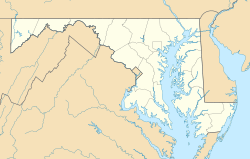Acquinsicke facts for kids
Quick facts for kids |
|
|
Acquinsicke
|
|
| Nearest city | Pomfret, Maryland |
|---|---|
| Area | 15.2 acres (62,000 m2) |
| Architectural style | Federal |
| NRHP reference No. | 92000070 |
| Added to NRHP | February 20, 1992 |
Acquinsicke is a historic house located near Pomfret in Charles County, Maryland, United States. It was built a long time ago, between 1783 and 1798. This house is a great example of Federal architecture, a popular style from the late 1700s.
The house is a rectangular, two-story building. It has five sections (called bays) and is covered with clapboard siding. There are also one-story additions on each end. Around the house, you can see a cool landscape with two terraced (stepped) levels.
Contents
History of Acquinsicke
How Acquinsicke Got Its Name
The name Acquinsicke comes from a large piece of land, about 1,000 acres (405 hectares). This land was first given to Jerome White in 1669. It was known as White's Ford. Jerome White came to Maryland from England around 1661. He was well-educated and held important jobs, like deputy governor.
When Jerome White died without leaving a will or family, the land went back to the Lords Baltimore. Later, in 1704, Anthony Neale received the land. He renamed it Acquinsicke. The name "Acquinsicke" likely came from a word used by Native Americans who lived in that part of Charles County at the time. It might even have been the name of a small village.
The Neale Family and the House
Anthony Neale recorded his ownership of the land in 1706. He probably built his home, a plantation, soon after. Before this, he lived on his father's land, Wollaston Manor. Anthony's father, Captain James Neale, was an important person in colonial Maryland. He was a planter and served as an ambassador for the King of England.
The Neale family were strong Catholics. During the years 1691–1776, Catholics in Maryland faced challenges and were not allowed some basic rights. The Neale family helped support the Church. Anthony Neale's home at Acquinsicke was even used as a mission chapel. This was a place of worship for local Catholics, connected to St. Thomas Manor.
Passing Down the Property
Anthony Neale passed away in 1723. In his will, he left half of the Acquinsicke plantation to his son, Edward. This half included the family home. Edward also received a "silver Chalice & suit of Church Stuff" to be kept in the house for the family's use. Anthony's other son, Charles, received the northern part of the plantation.
Anthony Neale was a wealthy person for his time. Even though his house was small, he owned valuable items like a clock, books, silver, and a violin. He also owned other properties and had many workers.
Edward Neale continued to live at Acquinsicke until the mid-1740s. He then moved to Queen Anne's County. Acquinsicke continued to be a place of worship for local Catholics. In 1751, Edward Neale gave his share of Acquinsicke to his daughter Eleanor and her husband, Henry Rozer. Seven years later, Charles Neale sold his half of Acquinsicke to Colonel Samuel Hanson.
Acquinsicke's Place in History
Building Styles in Southern Maryland
Acquinsicke was built in the late 1700s. This was a time of big changes in how homes were designed in Southern Maryland. Before the American Revolution, most houses were simple. Middle-class homes were usually one story with a few rooms. Wealthier homes might have four rooms and bedrooms in the attic.
It was rare to see two-story houses with hallways going through the middle before the late 1700s. As the economy improved in the early 1800s, more two-story homes with central hallways became common. New architectural styles, like neoclassicism, were slow to reach Southern Maryland.
A Special Catholic Connection
Acquinsicke is important because it shows the architectural style of its time. It also has a strong connection to the history of Catholicism in Southern Maryland. The land was part of a large plantation started by Anthony Neale, whose family was very important to Maryland's Catholic history.
The original Neale home, which may have been on the same spot as the current house, was used as both a family home and a mission chapel. This chapel was served by the Society of Jesus (Jesuits) from St. Thomas Manor. During the time when Catholics faced challenges (1690–1776), these mission chapels were vital for the survival of Catholicism in Maryland.
Most of these old mission chapels have disappeared, and their exact locations are unknown. Today, only St. Thomas Manor and St. Mary's Church in Newport are clearly linked to the early history of Roman Catholicism in this area. Acquinsicke is the only private home that still exists with a proven link to the Jesuit missionary work in this region.
Today, Acquinsicke is privately owned.
Why Acquinsicke is Important
Acquinsicke is a very important example of late 18th-century, early Federal architecture. It shows how building styles changed from older, simpler ways to more modern designs. Its two-story height, one-room-deep layout, finished attic rooms, and unique chimneys make it stand out. These features, when seen together, make Acquinsicke truly special and unmatched for its time.
Acquinsicke is also important because of its historical link to Roman Catholicism in Southern Maryland. There is strong evidence that the house sits on or very close to the site of an earlier building. This older building served as both a private home and a mission chapel from about 1706 until the mid-1700s. It was used by Jesuits from St. Thomas Manor.
Acquinsicke is one of only three places in Charles County with clear connections to the Roman Catholic Church's activities during the 1690–1776 period. This was a time when Catholics in Maryland were not allowed some of their basic civil rights.
See Also
- Acquinsicke, including undated photo, at Maryland Historical Trust



